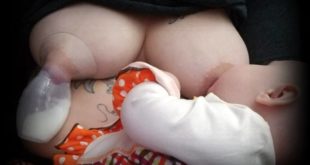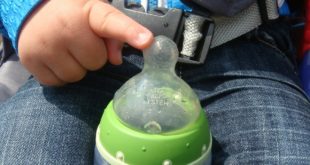 Breast fullness is a normal part of lactation which nearly all women experience when their milk ‘comes in’ 2 – 5 days after birth. This feeling of fullness, which may be accompanied by a feeling of heaviness, tenderness, and warmth, is caused by swelling of the breast tissue as blood, lymphatic fluid, and milk collect in the ducts as the process of milk production begins. With this normal fullness, the breast tissue is compressible, and you generally feel well (you rarely have pain or fever).
Breast fullness is a normal part of lactation which nearly all women experience when their milk ‘comes in’ 2 – 5 days after birth. This feeling of fullness, which may be accompanied by a feeling of heaviness, tenderness, and warmth, is caused by swelling of the breast tissue as blood, lymphatic fluid, and milk collect in the ducts as the process of milk production begins. With this normal fullness, the breast tissue is compressible, and you generally feel well (you rarely have pain or fever).
This normal breast fullness can develop into engorgement if the baby isn’t nursing often enough or vigorously enough, or if you are separated from your baby and don’t remove the milk frequently and effectively. When the normal breast fullness is not relieved, fluid builds up and swelling occurs. The breasts become hard, and the skin is taut and shiny. They become extremely tender and painful, and you may run a low-grade fever and become achy. The swelling may extend into the area under the arms, and in very severe cases can cause numbness or tingling of your hands from pressure on your nerves. Because the breast is so full and swollen, the nipple and areola may flatten out (sort of like a water balloon) making the tissue difficult for the baby to grasp. Nipples that are flat or inverted tend to flatten even more when the breasts are swollen. The article Flat or Inverted Nipples has more information about how to handle this problem.
If severe engorgement is not relieved, the alveoli (milk producing cells at the end of the milk ducts) can become atrophied and may decrease milk production. If the buildup of milk and fluid is not removed, swelling can occur to the point where the milk ducts will actually swell shut, making it much more difficult to get the milk out. Unrelieved engorgement can also lead to plugged ducts and mastitis.
Use of drugs to “dry up the milk” is not recommended. These drugs not only are not very effective, but they can have serious side effects and may cause rebound engorgement after the medication is discontinued.
Suggestions for Preventing/Handling Engorgement:
- Nurse frequently. Try to nurse at least 10-12 times in 24 hours – every 1 ½ – 2 hours during the day, with no more than a 3 hour stretch at night.
- Try to nurse for at least 15 minutes on the first side before offering the second. Don’t set time limits on time spent at the breast.
- Nurse baby with only a diaper on (skin- to -skin contact will stimulate sucking).
- Vary nursing positions to help promote drainage of the breast.
- Wear breast shells (with holes for air circulation) for 20 minutes between feedings.
- Wear a supportive bra (avoid under-wire), but don’t bind your breasts – this can lead to plugged ducts.
- Lie flat on your back between feedings so that your breasts are elevated.
- Apply cold compresses to your breasts and under your arms between feedings. Cold can help reduce swelling. Use a layer of fabric between the compress and the skin. Bags of frozen vegetables or a disposable diaper that you dampen and put in the freezer for 20 minutes work just as well as the ice packs that you purchase at the drugstore. Apply cold compresses for 15-20 minutes off and on and off for 1-2 hours.
- The use of heat immediately before nursing can help the milk let-down. Taking a warm shower, leaning over a basin of warm water, soaking in a warm bath, or applying warm compresses or a heating pad may help. Moist heat is best. Gentle breast massage can also help the milk flow more readily.
- If the nipple and areola are swollen, don’t try to nurse without softening them up first. Hand express or pump a little milk from your breast to soften the nipple and areola before trying to nurse. Gently massage the breast before nursing. If you use an electric pump, set it on MINIMUM and gradually increase the pressure after the milk begins to flow. You may not be able to turn it up to maximum, but try to increase the pressure as much as you comfortably can. Most pumps work better on the higher settings, but if the breast and nipple tissue is extremely tender or sore, don’t try to increase the suction. Apply a few drops of olive oil to your nipple and areola before pumping to help prevent friction while pumping.
- Be careful about the type of pump you use. Many of the small inexpensive electric pumps can damage your tissue, since engorged breasts bruise easily due to increased blood volume. If you don’t have access to a high quality pump which cycles automatically, you may want to stick with manual expression. Even with manual expression or massage, be very, very gentle.
If your breasts remain full, knotty, and tender after nursing, you may want to pump for 5-10 minutes to remove all the milk that comes out quickly and easily. Don’t be afraid that nursing or pumping will increase your milk supply and make the engorgement worse. At this early stage, when your milk is just coming in, remember that the fullness is a build up of other fluids (blood and lymph) as well as milk. Removing the milk will relieve the pressure and reduce the swelling, softening the areola and making it easier for the baby to latch on.
You may want to use cabbage leaf compresses if the above suggestions don’t bring you enough relief. This sounds really strange, but this is a remedy that has been used for over a hundred years with much success. No one is exactly sure why it works, but since it is inexpensive, safe, and effective, you may want to give it a try. Here’s what to do:
- Buy plain green cabbage.
- Rinse and dry leaves. Put them in the refrigerator.
- Remove base of hard core vein and gently pound leaves.
- Wrap around breast and areola, leaving the nipple exposed. The leaves fit nicely around the breast, and the cold feels good.
- Cover entire breast, and if needed, the area under your arms.
- Change every 30 minutes or sooner if they become wilted.
- Check your breasts often and as soon as you feel the milk beginning to drip, or if your breasts feel ‘different’, remove leaves and try to nurse or pump.
- Re-apply as needed (up to 3 times between feedings). Check OFTEN, as over use can cause a decrease in your milk supply.
- If pain and swelling persist, using OTC (over the counter) medication may help. Acetaminophen, the main ingredient in Tylenol, helps relieve pain, but ibuprofen, the main ingredient in Motrin and Advil, provides pain relief and also reduces inflammation. Both ibuprofen and acetaminophen are considered safe for nursing mothers, but ibuprofen is usually more effective than acetaminophen when treating engorgement, due to its anti inflammatory properties. (See article When a Nursing Mother Gets Sick for more information about OTC medications).
- Sage tea (available at health food stores) is a powerful herb that contains a natural form of estrogen and may decrease your milk supply. Drinking a cup at bedtime for a night or two may help in cases of severe engorgement. As with cabbage leaves, monitor breast changes often as over use can decrease your supply.
- Call your doctor if your temperature rises over 101, or if you develop localized pain or flu like symptoms. Even if you develop a breast infection, breastfeeding can and should continue.
Remember that engorgement usually subsides within 24-48 hours, so hang in there. Severe engorgement that is not treated promptly may take up to a week to resolve, and there is a greater risk of developing a breast infection. During this uncomfortable period, take comfort in the fact that most mothers who experience engorgement usually have more than adequate milk supplies once the initial period of discomfort is over. Lactation Consultants worry much more about mothers who don’t experience some degree of breast fullness during the postpartum period than those who do.
It is also important to note that the uncomfortable fullness you experience in the first few days after your baby’s birth is due to a hormonal rush that will never again be duplicated. You may experience some degree of engorgement later on if your baby sleeps a long stretch for the first time, or if you are separated from your infant, but you will never again have the same hormonal response that you will have immediately after his birth.
Anne Smith, IBCLC
Breastfeeding Basics
(Edited October, 2016)
* Please ‘Pay it Forward’!*
 If you found the information in this article helpful, please consider making a small donation to my favorite cause – Project Pets: Spay, Neuter, Love – an all volunteer, non-profit organization that provides free spay and neuter services for homeless dogs and cats…because every baby deserves a home, whether they have two legs or four! To find out how you can help, visit Project Pets on Facebook.
If you found the information in this article helpful, please consider making a small donation to my favorite cause – Project Pets: Spay, Neuter, Love – an all volunteer, non-profit organization that provides free spay and neuter services for homeless dogs and cats…because every baby deserves a home, whether they have two legs or four! To find out how you can help, visit Project Pets on Facebook.
 Breastfeeding Basics
Breastfeeding Basics




